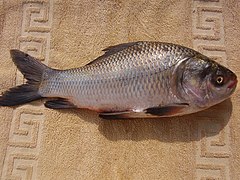
Acanthocephalus is a genus of parasitic worms. One of the species in this genus is Acanthocephalus anguillae, a fish parasite. Acanthocephalans are also found in humans and primates, causing a common zoonotic infection called "human acanthocephaliasis". While pathogens can be transferred among animals and humans, the main source of human acanthocephaliasis is the diet of infected raw fish and insects. Because they are lacking circulatory, respiratory, and digestive systems, Acanthocephalus are exceptionally well-adapted to a symbiotrophic existence.

The thorny-headed worm family Polymorphidae contains endoparasites which as adults feed mainly in fish and aquatic birds. When this taxon was erected by Meyer in 1931, a subfamily Polymorphinae was established in it. As the Polymorphidae as presently understood would then be monotypic, with no basal genera outside the Polymorphinae, the proposed subfamily is redundant for the time being and therefore most modern treatments simply omit it. Polymorphus minutus is an economically significant parasite in goose and duck farming.

Moniliformidae is a family of parasitic spiny-headed worms. It is the only family in the Moniliformida order and contains three genera: Australiformis containing a single species, Moniliformis containing eighteen species and Promoniliformis containing a single species. Genetic analysis have determined that the clade is monophyletic despite being distributed globally. These worms primarily parasitize mammals, including humans in the case of Moniliformis moniliformis, and occasionally birds by attaching themselves into the intestinal wall using their hook-covered proboscis. The intermediate hosts are mostly cockroaches. The distinguishing features of this order among archiacanthocephalans is the presence of a cylindrical proboscis with long rows of hooks with posteriorly directed roots and proboscis retractor muscles that pierce both the posterior and ventral end or just posterior end of the receptacle. Infestation with Monoliformida species can cause moniliformiasis, an intestinal condition characterized as causing lesions, intestinal distension, perforated ulcers, enteritis, gastritis, crypt hypertrophy, goblet cell hyperplasia, and blockages.

Echinorhynchus is a genus of acanthocephalan parasitic worms. They parasitize a wide variety of fishes from both marine and fresh waters. The intermediate host is usually a crustacean.
Centrorhynchidae is a family of parasitic worms. Three species of these thorny-headed worms in the genus Centrorhynchus were found to parasitize birds of prey and owls Slovakia. These hosts include Buteo buteo, Buteo rufinus, Falco tinnunculus, Asio otus, Strix aluco, Strix uralensis and Tyto alba.
Arhythmacanthidae is a family of parasitic worms from the order Echinorhynchida.

Cavisomidae are a family of parasitic worms from the order Echinorhynchida.

Illiosentidae is a family of parasitic worms from the order Echinorhynchida.

Neoechinorhynchidae is a family of parasitic worms from the order Neoechinorhynchida.

Rhadinorhynchidae is a family of parasitic worms from the order Echinorhynchida.
Plagiorhynchidae is a family of parasitic Acanthocephalan worms.
Polymorphus is a genus of parasitic worms from the phylum Acanthocephala. This group uses amphipod crustaceans as intermediate hosts and various birds as final hosts.
Acanthogyrus is a genus of parasitic worms belonging to the family Quadrigyridae. The species of this genus are found in Africa.
Rhadinorhynchus is a genus of worms belonging to the family Rhadinorhynchidae.
Isthomosacanthidae is a family of parasitic spiny-headed worms.
Quadrigyrus is a genus in Acanthocephala.
Pararaosentis is a monotypic genus of acanthocephalans containing a single species, Pararaosentis golvani.
Pallisentis is a genus in Acanthocephala.
Neoechinorhynchus is a genus of parasitic worms belonging to the family Neoechinorhynchidae.

Pseudoacanthocephalus is a genus of parasitic worms belonging to the family Echinorhynchidae.









